NCERT Solutions for Class 4 EVS Chapter 2 - Exploring Our Neighbourhood
| Table of contents |

|
| Page No. 18 |

|
| Page No. 19 |

|
| Page No. 20 |

|
| Page No. 21 |

|
| Page No. 22 |

|
| Page No. 23 |

|
| Page No. 25 |

|
| Page No. 26 |

|
| Page No. 28 - 29 |

|
| Page No. 30 |

|
| Page No 31 - 32 |

|
Page No. 18
Activity 1
Q1: Write a letter to a friend and post it.
Ans:
Dear [Friend's Name],
I hope you are doing well! I wanted to tell you about something fun I did last weekend. I went to the park with my family and we played games, had ice cream, and enjoyed the sunny weather. It was so much fun!
I also wanted to ask if you would like to come over to my house next Saturday. We can play and have a lot of fun together. Let me know if you can come.Take care, and I hope to hear from you soon.
Your friend,
[Your Name]
Once you write the letter, put it in an envelope. Don't forget to write your friend’s address on the envelope and post it in a red postbox.
How to do it: Use paper, a pen, and an envelope to write your letter. Ask your parents or teacher to help you find a postbox nearby.
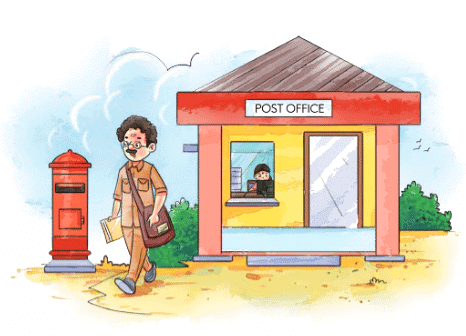
Q2: Teacher can take students on a field trip to a post office to explore various activities that take place there.
Ans: The teacher can take us on a fun trip to the post office. There, we will learn how letters and parcels are sent and received. We will see where the letters are dropped in the postbox and how they are sorted by the workers. We can also learn about other services like money orders and buying stamps. It will be an exciting trip where we can ask questions and learn how important the post office is for sending messages to our friends and family.
Page No. 19
Write
Q1: Have you or your family members ever sent, or received a letter or a parcel?
Ans: Yes, my family and I have sent and received letters and parcels. We have sent Rakhi on Raksha Bandhan, and I have received parcels from relatives. The post office is where people send and receive letters and parcels.
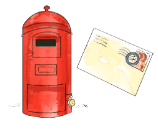
Q2: How does the post office help people stay connected with each other?
Ans: The post office helps by sending letters, parcels, and important documents to people. It ensures that messages can reach others even if they live far away.
Page No. 20
Activity 2
Interview with Elders
Discuss with the elders in your neighbourhood and find out how they communicated with each other when they were of your age. Compare their answers to how you and your friends communicate today; and fill in the table below: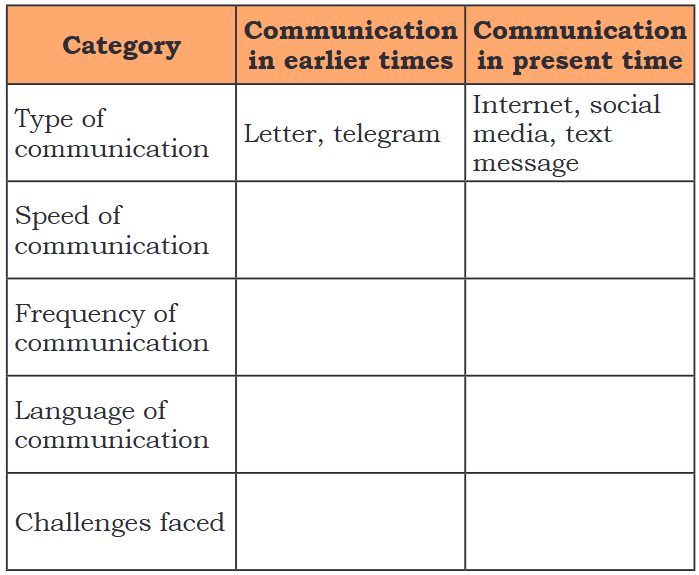 Ans:
Ans:
When I discussed with the elders in my neighborhood, they shared that when they were my age, communication was very different from today. They primarily communicated through letters and face-to-face conversations. They used the telephone, but it was landline-based, and there were no mobile phones or social media. Letters were a common way of sending messages, especially to distant relatives.
Today, my friends and I communicate using mobile phones, instant messaging apps, and social media platforms. We send text messages, make video calls, and share photos instantly. Communication is much faster and more accessible now compared to the past.
Here’s a comparison: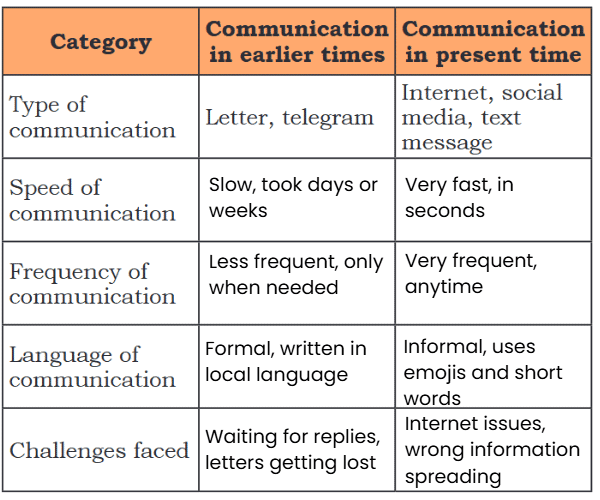
Page No. 21
Discuss
Q1: Letters took a long time to reach other persons. How do you think it affected communication between people in the past?
Ans: In the past, communication was slow because letters took a long time to travel. It made it difficult for people to get quick answers or updates.
Q2: How is it different from the way people communicate now?
Ans: Now, people communicate instantly using mobile phones, the internet, and social media. It is much faster to send messages and stay in touch.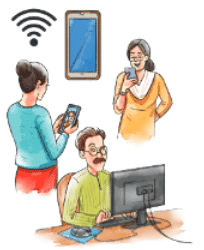 Q3: Today quick messages make sharing the news easier, but sometimes wrong information spreads very quickly too. How can we ensure the news we share is true?
Q3: Today quick messages make sharing the news easier, but sometimes wrong information spreads very quickly too. How can we ensure the news we share is true?
Ans: To make sure the news we share is true, we should verify it from reliable sources before passing it along. It's important to check the facts.
Page No. 22
Write
Q1: Which mode of transportation do you use the most?
Ans: The mode of transportation I use the most is a bus. It is convenient and affordable.
Q2: Can you identify the structures in the pictures, and explain how they have made travel faster and connectivity better?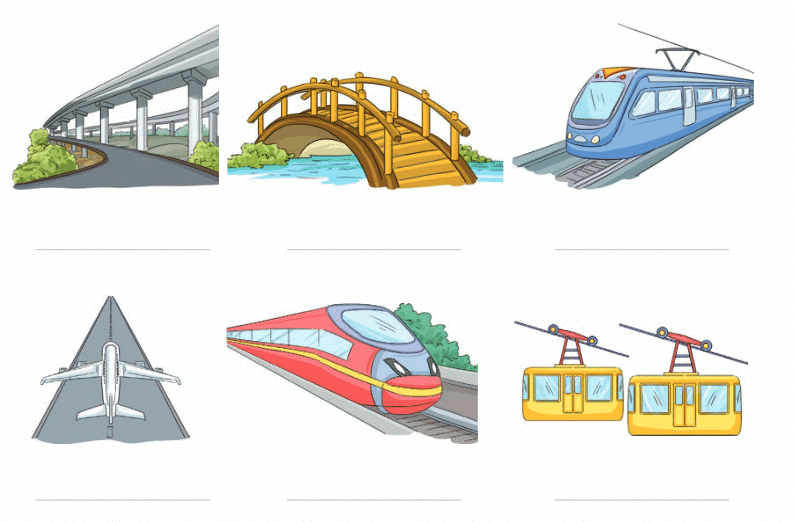 Ans:
Ans: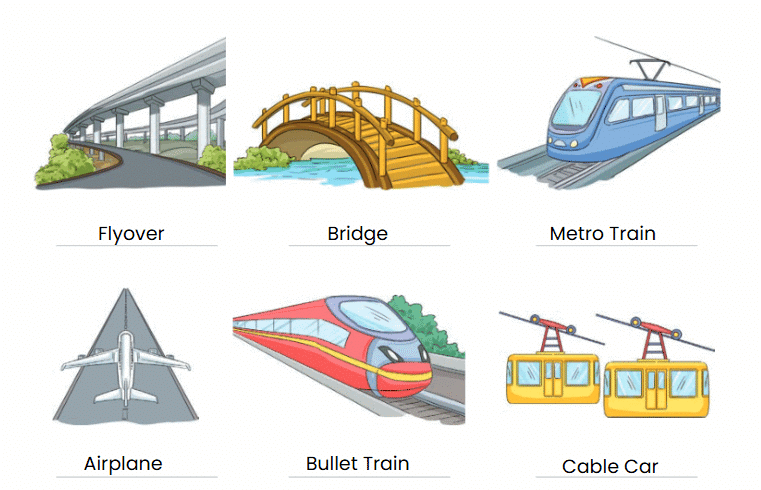
- Flyover: The flyover helps cars and buses travel above the roads and intersections. This saves time by avoiding traffic and helps people reach their destinations faster.
- Bridge: A bridge allows vehicles and people to cross over rivers or other obstacles. It makes traveling easier and faster by providing a safe way to cross places where there are no roads.
- Metro Train: A metro train runs on tracks in cities and moves quickly between stations. It helps many people travel faster in busy cities, reducing traffic on the streets.
- Airplane: An airplane flies in the sky and helps people travel long distances quickly. It makes travel much faster compared to traveling by road or train.
- Bullet Train: The bullet train travels very fast on dedicated tracks. It helps people travel long distances quickly, especially between cities, making travel time shorter.
- Cable Car: A cable car is a small vehicle that moves along a wire. It is used in places like mountains to carry people up and down, and it helps reduce the time it takes to climb steep areas.
Page No. 23
Find Out
Q: How did your parents and grandparents go to school or other places, when they were of your age? Is it different from how you travel today? Note it down below. Ans:
Ans:
- I travel by school bus or e-rickshaw, which is fast and safe.
- My parents used bicycles or walked to school, which took more time.
- My grandparents walked or used bullock carts, which were slow and tiring.
Today’s travel is much faster and easier!
Write
Q: List the people who work at a hospital or a health centre; and write down their role in the following table. Ans:
Ans: 
Page No. 25
Discuss
Q: If you had to send money to someone, which method would you choose—using a phone, Money Order, or some other mode? Why?
Ans: I would choose to send money using a phone because it’s fast, easy, and safe. You can send money in seconds using apps, and you don’t need to visit a post office like with a Money Order.
Write
Q1: If you get pocket money, do you save it? If yes, where do you put your savings?
Ans: Yes, I save my pocket money in a piggy bank at home. It keeps my money safe for things I want to buy later.
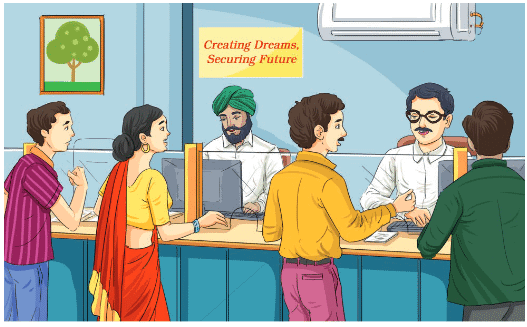 Scene of a BankQ2: Why do you think it is important to save money?
Scene of a BankQ2: Why do you think it is important to save money?
Ans: Saving money is important because it helps us buy things we need in the future, like books or toys. It also helps during emergencies, like if we need to visit a doctor.
Q3: What are some things you could do to save more money?
Ans: To save more money, I can:
- Spend less on snacks or toys.
- Put some pocket money in my piggy bank every week.
- Avoid buying things I don’t need.
Q4: Request one of your family members to show you their bank passbook. Note the important elements given on the first page of the passbook.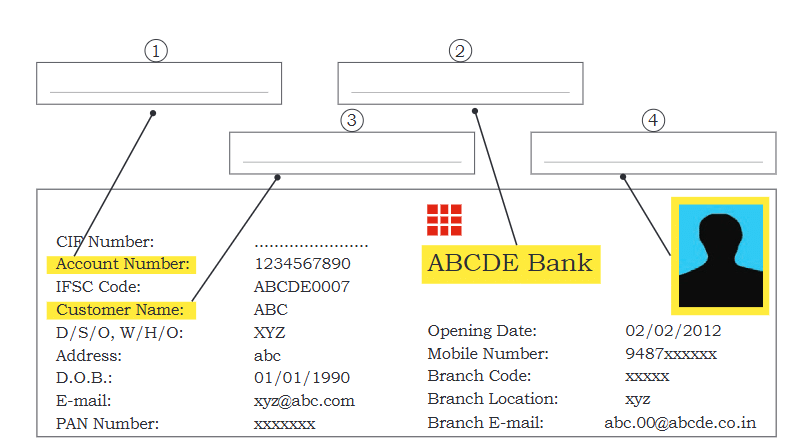 Ans: The important elements on the first page of the bank passbook are:
Ans: The important elements on the first page of the bank passbook are:
- Account Number: This is the number for the customer's bank account.
- Name of the Bank: The name of the bank where the account is held.
- Customer Name: This is the name of the person who owns the bank account.
- Photo of the Person: A photo of the account holder, used for identity verification.
Some other elements include:
- D.O.B. (Date of Birth): This is the customer's birth date.
- Address: The customer's home address.
- Mobile Number: The customer's phone number linked to the bank account.
- PAN Number: This is a unique number that helps in income tax-related work.
- CIF Number: This is a unique number that identifies the customer in the bank's system.
- IFSC Code: This code helps in transferring money between banks.
These details are important because they help the bank know who owns the account and ensure that money transactions are done safely.
Page No. 26
Activity 3
Q1: Visit a bank in your locality or find out from your elders about how it works. After that, answer the following questions:
(a) Other than saving money, what else do people use banks for?
(b) What is an ATM and how does it help people?
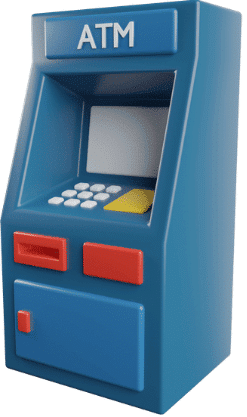 ATM
ATM
Ans: (a) People use banks to:
- Take loans for buying a house or car.
- Pay bills.
- Send money to others.
- Keep valuable things safe in lockers.
(b) An ATM is a machine that lets people take out money, check their balance, or deposit money anytime. It helps because you don’t need to visit the bank or wait in a queue.
Q2: Take an Indian currency note. Look at it closely and answer the following questions:
(a) What is the value of the note?
(b) How many languages do you see on the note?
(c) What pictures or symbols are there on the note?
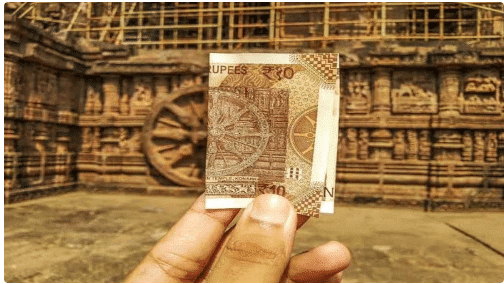 Sun Temple on 10 Rupee NoteAns: (a) The value could be ₹10, ₹20, ₹50, ₹100, ₹200, or ₹500 (depending on the note you have).
Sun Temple on 10 Rupee NoteAns: (a) The value could be ₹10, ₹20, ₹50, ₹100, ₹200, or ₹500 (depending on the note you have).
(b) There are 15 languages on an Indian currency note, including Hindi, English, and 13 other Indian languages.
(c) The note has:
- A picture of Mahatma Gandhi.
- The value of the note in numbers and words.
- The Reserve Bank of India logo.
- A special picture, like the Sun Temple, Konark on 10₹ note and Stone Chariot of Hampi, Karnataka on 50₹ note are there.
Page No. 28 - 29
Q1: Look at the picture above, and write down the places located in the North, East, West, and South of Navya's home.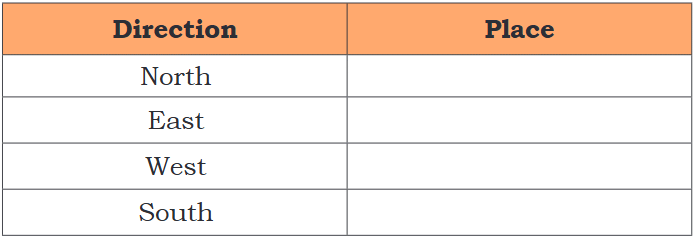 Ans:
Ans: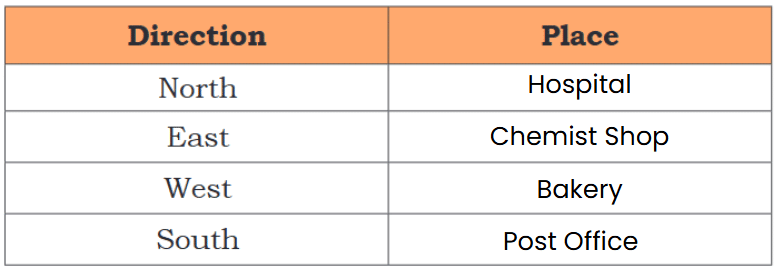
Q2: Look at the picture on the next page, and imagine your school at the centre. Name the buildings or areas near your school and write the direction they are situated in the given spaces.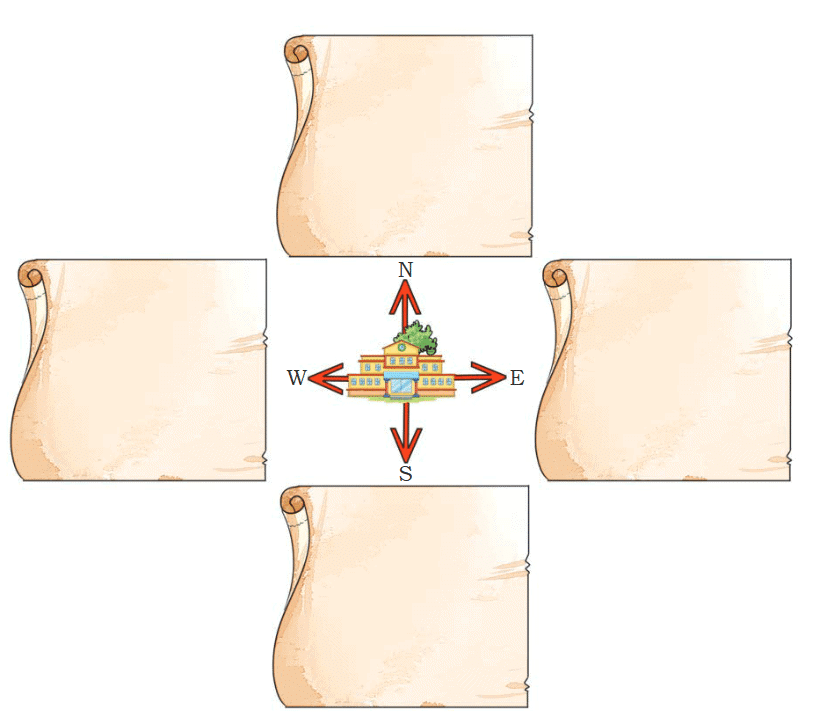
Ans: 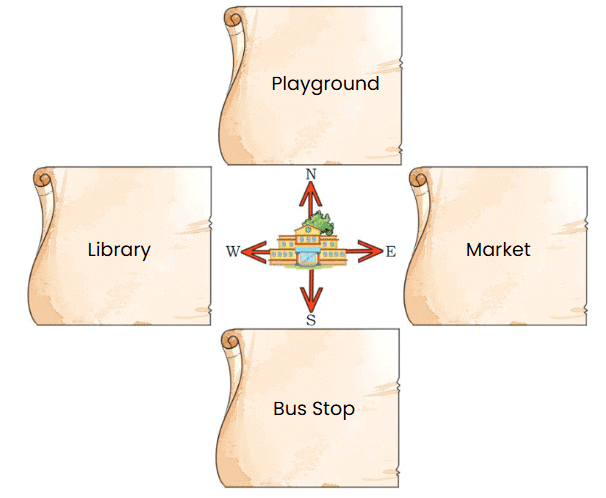 (This depends on your school, but here’s an example.) Near my school, the playground is north, the market is east, the bus stop is west, and the library is south.
(This depends on your school, but here’s an example.) Near my school, the playground is north, the market is east, the bus stop is west, and the library is south.
Q3: Imagine you are giving directions to a friend to visit your favourite place near your school. How would you explain it using directions (left, right, forward, backward, etc.) and landmarks? Ans:
Ans:
Page No. 30
Activity 4
Q: Draw a map showing the route from your school to the public library or any such place near your school. Identify landmarks like parks, shops, hospitals, bus stops, etc. on the map.
Ans:
Here is a sample map showing the route from my school to the public library. Have mentioned landmarks like park, a shop, a hospital, post office, etc. on the map.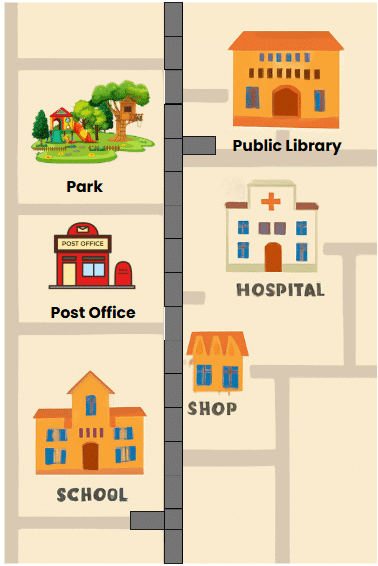
Suggestion for better Map: Draw a simple map on paper. Start with your school in the center. Draw a path to the library. Add landmarks like:
- A bus stop near the school.
- A park on the way.
- A shop next to the library.
- Use arrows to show directions (north, south, east, west).
How to do it: Use a pencil, ruler, and colors. Label the landmarks clearly. Ask your teacher or parents about the real places near your school to make the map accurate.
Page No 31 - 32
Let us reflect
Q1: Imagine you have ₹100 to utilise in a month. Your task is to plan how to spend and save wisely. Think about your expenses for stationery, snacks, toys, etc. Decide how much you will save in your piggy bank and how much you will use for your expenses. After making this plan, think about how saving money could help you in the future.
Use the table below to create your budget: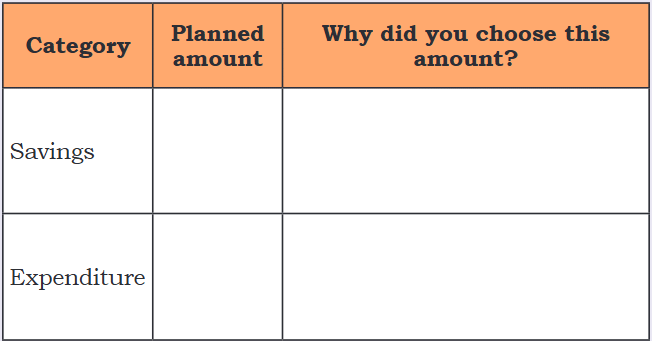 Ans:
Ans: 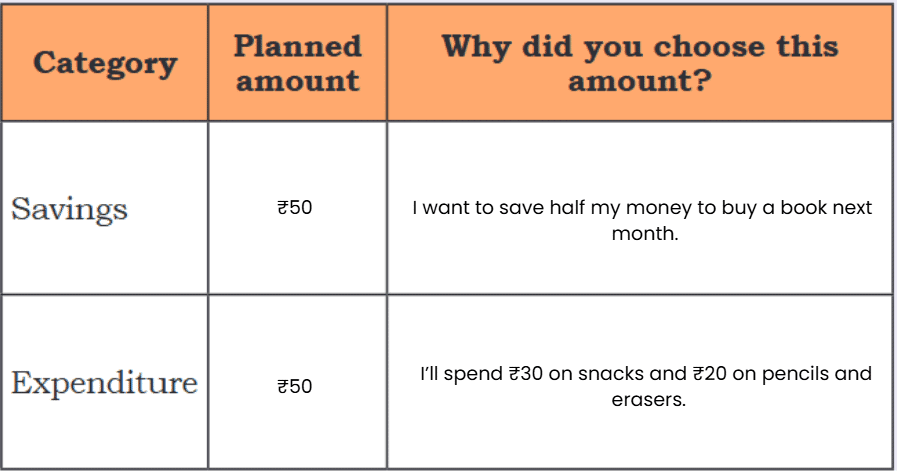
Saving ₹50 helps me buy something big later, like a book. Spending ₹30 on snacks and ₹20 on stationery is enough for my needs this month.
Q2: Imagine that your group is in charge of making your neighbourhood better. Discuss what new services or facilities you would add or improve. Present how these changes would help everyone in the community.
Ans: My group would add a new park with swings and trees. It would help because:
- Kids can play safely.
- Families can relax and meet others.
- Trees will keep the air clean.
Q3: As a class, take help of the elders around you to list people in your neighbourhood who helped the community during COVID-19. These could include doctors, nurses, garbage collectors, shopkeepers, teachers, and others. Discuss how they made the community safer and why it is important to thank them.
Ans: During COVID-19, people who helped were:
- Doctors and Nurses: Treated sick people in hospitals.
- Garbage Collectors: Kept the area clean to stop germs.
- Shopkeepers: Sold food and essentials.
- Teachers: Taught online so we could keep learning.
- They made the community safer by working hard even when it was risky. We should thank them because they helped us stay healthy and happy.
Q4: Can you list out the people involved and vehicles used in each of these services in the boxes given below?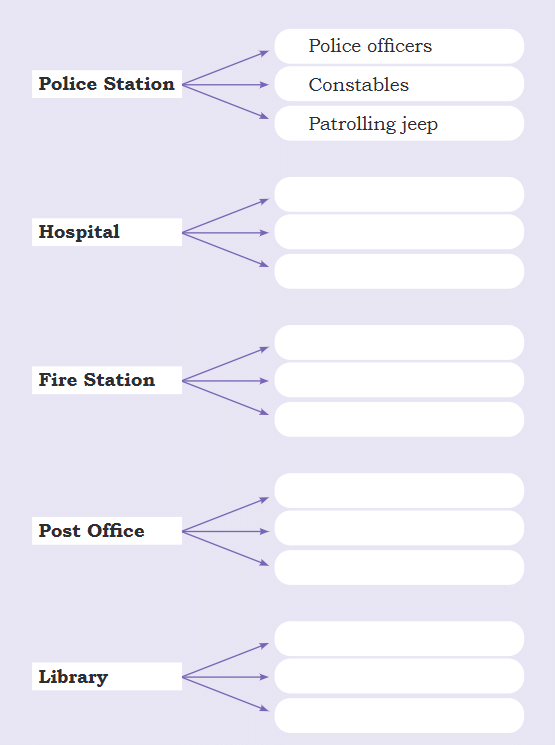 Ans:
Ans: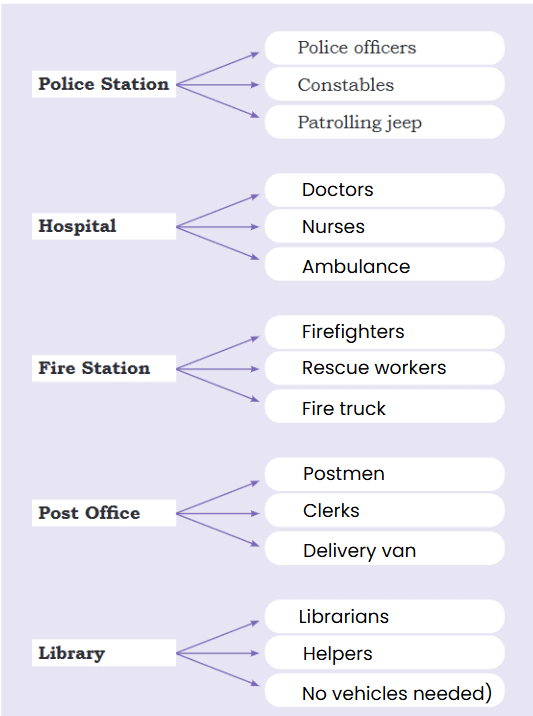
|
21 videos|111 docs|10 tests
|
FAQs on NCERT Solutions for Class 4 EVS Chapter 2 - Exploring Our Neighbourhood
| 1. What is the importance of exploring our neighborhood? |  |
| 2. How can we learn about the different places in our neighborhood? |  |
| 3. What are some common places we might find in our neighborhood? |  |
| 4. Why is it important for children to explore their neighborhood? |  |
| 5. How does exploring our neighborhood contribute to community development? |  |
















